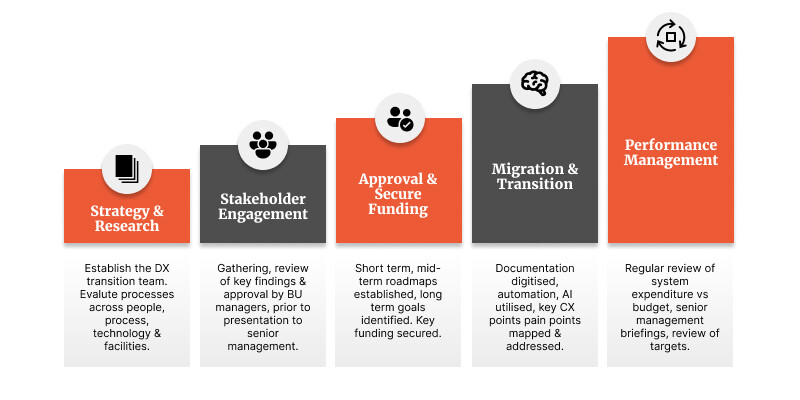In this article
What is IT strategic planning?
Much like a strategic business plan, an IT strategic plan provides a clear map of where a business wants to evolve its IT, and the steps they plan to take to achieve this. This then works to inform the company’s IT decision making, and guides the business as it implements its overall strategic plan and business objectives.
When undertaken correctly, it identifies the ways in which a business’ IT facilitates decision making, and pinpoints where IT resources can optimise business processes to capitalise on the financial investment required to achieve success.
But this doesn’t mean it’s set in stone. Instead, IT strategic planning focuses on the business end goals, while delivering on its strategic vision via a flexible roadmap that allows for changes in technology and business priorities.
In fact, good IT strategic planning acknowledges that the future is uncertain. It understands that technology is changing. But when undertaken comprehensively, a thorough IT strategic plan builds in adaptability and insight that enables the organisation to look past the horizon, and helps them include the capacity for future technology as it evolves.
Why an IT strategic plan is necessary
Without robust IT strategic planning, a business is operating in the dark. No long-term strategy means it’s relying on a short-term focus, jumping from goal to goal, with no clear plan in mind.
Working this way is unsustainable, and only serves to stifle growth.
Proper IT strategic planning ensures a business is able to set itself up for the future—and more than just being future-proof, it finds itself future enabled.
IT strategic planning ensures that an organisation is able to continue adapting its systems and technology to whatever the future holds. It ensures that the business user experience remains smooth and seamless throughout these changes; that users in all business areas can access the technology and platforms they need to perform their day-to-day roles effectively.
From an external angle, it helps to protect against business risk, building in contingency across the board, whether in terms of IT issues, data security, and even plans for future disruption.
When undertaken holistically, it ensures consumer focused businesses can flexibly face future changes, and act in an agile manner, regardless of what the future holds. An organisation can seamlessly integrate digital transformation initiatives, and business objectives, while continuing to evolve its five-year goalsetting as the goalposts change.
The benefits of IT strategic planning
IT strategic planning enables a business to be prepared for technological change, whether it’s over a one-, two-, five-year horizon, or further. And rather than simply providing a map for technology upgrades, IT strategic planning has some important business benefits.
Enables flexibility and speed in decision-making
A comprehensive IT strategic plan means that a business is prepared for any scenario. For employees at every level, from its C-suite team to the frontline workers, this means that they have a game plan to follow, and there’s clear direction as the business navigates the ever-changing business waters.
But change doesn’t have to be negative. A comprehensive IT strategic plan keeps a business across technological updates, enabling them to leverage new systems, platforms, and technologies as they become available. The right platforms are able to be rolled out seamlessly to enable business continuity: things like taking advantage of improved AI, or integrating IoT technology into their supply chains.
This empowers the organisation to swiftly respond to change without it disrupting the business. It enables them to deploy the right platforms at the right time, delivering improved decision making and keeping it on course to meet business objectives.
Reduces costs over the long-term
It’s not just about saving money. To truly reduce costs, a business needs to be prepared for future developments.
In an IT setting, this can include building in budget for funding future projects, and ramping up future funding to properly integrate new technologies into a business’ workflows. This can include planning out when and how to engage IT change consultants.
With the right IT strategic plan development, this ensures that a business has the funds and the capacity to adopt new technologies and processes seamlessly, reducing staff training time, friction to adoption, and ensuring minimal business disruption as these new platforms are brought online.
While the initial up-front costs may appear higher, money invested in the correct implementation and deployment of IT technology and resources ensures the business can capitalise on this new technology faster, and gain a better advantage in their market sooner.
Builds a more resilient business
Disruption in a business is inevitable. But this is one of the biggest benefits of IT strategy planning: it enables the business to put IT plans in place that are designed to face adversity, and manage it in real time, without the business grinding to a halt.
An organisation will already likely have plans in place to manage things like fire, theft, and other physical disruptions—but with an IT strategic plan, a business can ensure its data remains safe and secure, too, and it can adapt and adopt its IT practices as the business landscape changes.
Facilitates digital transformation
Businesses evolve over time, but sweeping change is typically attacked as part of a business transformation initiative. So the key area that a Chief Technology Officer and other business IT leaders will use their IT strategic plan is in their technology strategy, to ensure they’re advancing their organisation’s capability in a forward-looking direction as technology evolves.
It sounds obvious, but business IT leaders need to make sure that their IT ecosystem and data center architecture are included as part of the transformation, and pave the way for future changes and disruptive technologies.
Things like having a 5G-ready business, distributed cloud architecture, adopting AI-powered automation and machine learning—these emerging technologies CTOs are looking to implement can’t be done in a vacuum. IT strategy planning needs to be included as part of the overall business strategies and planning.
The scenario planning and forecasting benefits it brings ensures that all business variables are accounted for, providing flexibility and agility in its roll-out, and that the business can adopt its digital transformation in line with its day-to-day functions.
What’s included in the strategic planning process?
Robust IT strategic planning can’t be half-baked—it needs to be undertaken with purpose and comprehensive planning. And while the specific activities undertaken in a business’ IT strategic planning process may vary, most planning will typically flow through these key stages.
1. Discovery
IT and business leaders will work together to identify challenges and opportunities within the business. This stage is about understanding what processes are working well, what could be improved, and how the business could better face future challenges.
Information will be gathered from internal and external stakeholders through surveys, interviews, and focus groups. The goal is to assess IT’s performance, identify any issues that people are facing, and explore opportunities for improvement.
2. Analysis and planning
After comprehensively identifying and categorising the business’ challenges, opportunities, strengths, and weaknesses, business IT leaders will analyse their data at hand to gain a clear understanding of where it’s required to invest resources, optimise processes, and the challenges they may face in doing so. Robust scenario planning is required at this stage, so the business can plan the most likely avenues for its technology investments, and understand the true business value of their investment.
3. Funding
The business must secure the necessary funding for their strategic initiatives to ensure they’re able to be rolled out successfully, and that it meets the requirements and resources required to deliver on their goals.
4. Ideation and implementation
This is where business IT leaders use their analysis to identify and define the strategic business objectives, deliverables and outcomes of their forthcoming IT strategy, over its desired timeframe. This focused strategic plan development helps to determine how IT goals relate to, and align with, business strategies and objectives, and ensure that risk mitigation is planned for.
This stage effectively outlines the mission statement and the roadmap to achieve its deliverables. It ensures every business decision is connected to the necessary investment, and that all the right roles and responsibilities are assigned against defined measurable goals. It’s the time to plan objectives, define what success looks like at every level, and build in the metrics that determine when success has been reached, with clear strategic direction.
Once this is completed, it’s time to implement your IT strategic planning.
5. Setting key performance indicators
If a business wants to stay competitive, it needs to set measurable goals and milestones when creating an IT strategic plan. These goals should be measurable without internal bias, and they should align with the company’s overall business strategy.
Setting measurable goals and milestones is an excellent way to ensure that your IT strategies yield positive results. For instance, if you want your website to generate more leads, then you could set a goal for improving overall website experience, with elements such as website load times and TTFB — and make improving it part of your IT strategy.
6. Establishing a mid term strategy
So you have a strategic plan, project management team spending your time on the right projects? Your mid-term horizon is key to ensuring that you not only execute the right tasks, but also the ones that will make the most difference to your bottom line. Remember that it’s always easier for project manager to focus on a short-term goal, but if you don’t take the long view then you might miss out on important projects.
IT leaders must focus on the mid-term horizon when creating their IT strategic plan. This time period is typically 12 to 18 months ahead.
Long-term plans still have their place, but they are less common in today’s rapidly changing business and technology landscape. It’s important to clarify the difference between the three operating horizons — operating plan, mid-term strategy, and long-term goals to ensure success.
7. Regular review
In their bid to play catch-up, many business owners have a tendency to move from one technology trend to another. However, this leads to them neglecting the essence of technology and its real purpose — to help businesses run better by addressing key pain points.
It is essential that IT strategic planning is not simply undertaken and then left to its own devices.
Businesses need to build in regular review and measurement of their IT strategic plan, and planning process, to ensure they are adapted to the future. This ensures the business is tracking against its goals, that the long-term strategic business objectives are still relevant, and IT can adapt as the business landscape evolves.
Common pitfalls to be aware of in your IT strategic plan
Focusing on tactics, rather than strategy
A common pitfall of all strategic planning is getting mired in the tactical elements that achieve the strategy, rather than focusing on the bigger picture. It’s critical for a business to keep a high-level view; it can build in goals that are tactically-driven, but mustn’t get so focused on what the IT department is doing that it loses its long-term view.
Your IT strategic plan is static
One key pitfall in strategic planning is that your strategy ends at the prescribed time. But what then? A good IT strategic plan continues to evolve and iterate—it’s not a once-and-done affair. A one-time plan like this gets a business to a certain point, but no further. In remaining dynamic, updating the planning regularly, and encouraging change and growth, the business is able to adjust its plans as its goals change.
Lack of clear ownership
The IT team doesn’t exist on its own island.
If you think of the IT team as a separate entity — with their own goals and needs — then you’re going to be missing out on an easy way to improve your company’s operations, infact the coherent amalgamation of IT strategy and business strategy can enrich firm performance.
Senior leadership teams want to hear from the IT department. But in order for them to hear, they must first listen. As such, it’s important to include key members of the leadership team in conversations about how technology can help the company achieve its goals. Without this involvement and buy-in, senior leadership will not be able to stay on top of the status of the IT department’s projects or its synergies with company-wide initiatives.
It’s prescriptive
A prescriptive, rigid IT strategic plan means that there’s no room to adapt, and no margin for error. Any deviation from the roadmap and goals is construed as a failure. Worse, it means that the IT strategy itself is failing to align with business goals. Nobody can say with 100% certainty what the future holds, so a strategic plan that doesn’t take this into account is doomed to fail right from the start.
The value of IT isn’t properly understood
While people at every level use IT, understanding the true value of IT, and how it facilitates business success in the modern world, can often go overlooked. So it’s important to ensure that all business leaders and key stakeholders involved in the planning stage understand the business value that IT delivers to the organisation—not just the IT leaders. This is critical in delivering a robust IT strategic plan. This direction needs to come from the top, understood and adopted by the Executive team, and involve business leaders at all levels.
The elements of a good IT strategic plan
Robust IT strategic planning helps a business to map out the technology investments required to help them meet key business objectives. It enables the business to map out the resources necessary to drive their transformation project, and identifies the goals and measurements for success.
When managed correctly, a robust IT strategic planning process will deliver:
- A big-picture view of the business, both from a current and future standpoint. What does success look like at every step, and how is it achieved? What’s occurring around these goals to ensure they’re met?
- A view that’s actually strategic. It takes a long-term view to help guide the business in its IT journey, while aligning with other business plans and strategies to help meet organisational goals and objectives. It’s visionary, high level, rather than getting bogged down in the tactical operating portion of the business’ plan.
- Disruption management. While the business may not necessarily plan out specific disruptions that they’ll face, robust IT strategic planning can at least put contingencies in place for different types of disruption, with steps and plans on how to manage it. There’s not many businesses that would have foreseen a global pandemic occurring—but businesses with a thorough IT strategy in place would have already had steps to follow should staff be required to work from home.
- Uniformity across business platforms. While not specifically addressing individual platforms and applications, a good IT strategic plan enables the business to identify shadow IT issues, and deploy solutions to solve this insidious issue. For those not aware, shadow IT is where non-approved programs and software is added into the business complement without express IT department approval. This can be a problem in larger organisations, and it means different teams and departments are using different technology, which can cause roadblocks in communication and ability to work cohesively towards business goals.
- Flexibility. A good IT strategic plan is dynamic, with built-in ability to change as the business landscape does. It’s ever-evolving, with business IT leaders revisiting it regularly, adjusting and amending so it continues to align with business goals and objectives. When undertaken correctly, it continues to update what the future looks like as the business peeks further and further over the horizon—the plan itself redefining what the horizon even looks like.
- Thorough communication. Robust IT strategic planning is only valuable if business leaders are on board, and aware of what’s involved. Having a high level IT strategic plan that’s communicated to and understood by your Executive team ensures it’s included in business planning and direction. IT strategy can then be communicated throughout the business, which ensures IT strategy is included in business decisions at every level.
- Cloud first approach. Start migrating your applications to the cloud that best fits their business priorities. Once you’ve moved them into the cloud, it’s crucial to monitor and adjust them to deliver against your targets for performance and cost. There are many factors to consider when deciding where to host your workloads, such as data sovereignty, regulations, and organizational skillset. Each of these can influence the decision-making process, so it’s important to weigh all options before making a final decision.
The unique strategic IT needs of government agencies
Government agencies face the unique issues of being both a service provider and operations. Governments are in charge of managing and providing services to the public, and they also need to have large information stores to operate efficiently.
A common concern of many commercial organizations is security, and when it comes to government IT security those needs are amplified. The Federal Government has been the source of many leaks of classified information over recent years that were both frequent and devastating.
In order to improve the security of their data, government departments need to be progressive in the process by which their data is created, transmitted, processed, and stored as their profile ensures they are a high priority target for hackers.
Data security needs to be a cornerstone within a broader 5 year government IT strategic plan.
Having challenges putting a successful IT strategy into practice?
As you can see, your business’ five-year goals are important—but they’re not the endpoint. Instead, they’re a stepping stone for future success, and ensure your company continues to evolve as available technology does.
So when it comes time to undertake your business’ IT strategic plans, how do you plan to navigate your business over each successive horizon? Are you certain your strategic objectives are tied to tangible business outcomes, and that your IT department has been involved in the strategic thinking?
At Techbrain, we help businesses deploy processes around technology alignment that create immediate impact, while facilitating long-term results.
Get in touch with us to discuss how we can help your business with your IT strategic plan, our VCIO services offer the help you need to create successful goals and strategic objectives for the next five years—and beyond.






